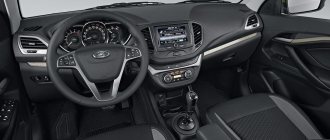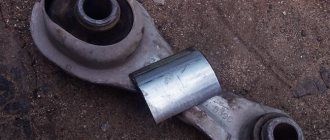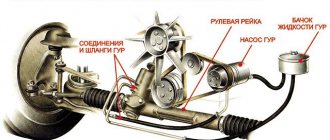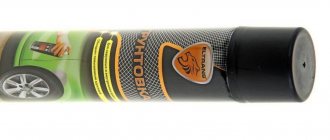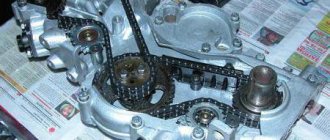Once upon a time, a Nobel laureate and Miss Universe met. “Let’s have sex and I’ll give birth to your children,” she suggested. - They will inherit beauty from me, and intelligence from you, and will be the best on the planet! “Perhaps they will take my beauty and your intelligence,” the laureate retorted.
Lada Vesta is certainly a beauty, but... What did car enthusiasts expect from the acquisition of AvtoVAZ by the Renault Nissan alliance? It is likely that the new Lada will have the quality and technology of foreign cars, but the “beautiful” Russian prices will remain. It definitely didn’t work out with the price, but what about the smart part, the technology? And what is more in Vesta, a foreign car or a Russian car? Perhaps it all depends on whether the glass of water seems half empty or half full, but let's figure it out...
Vesta's place among non-locals
For more than a year now, Vestas have been rolling off the assembly line and delighting happy car enthusiasts. During this time, the car showed itself at a high level. Previous Lada models are definitely inferior in many respects - within the Vesta brand there is no competition. But as for our foreign brothers, it makes sense to compete, which is what we will do today.
In this article we will separately compare such parameters as “appearance”, “dynamic characteristics”, “equipping options and prices”. The choice of competitors is quite large, but we will limit ourselves to five models that are most suitable for a fair and interesting fight:
- Volkswagen Polo Sedan
- Hyundai Solaris
- Renault Logan
- Skoda Rapid
- Kia Rio
All of the above cars are budget sedans with comparable technical characteristics and prices to the Lada Vesta. Each model has its own highlights and its own mistakes, which are more noticeable compared to other cars. But, since we are talking mainly about Lada Vesta, this new product of the domestic automobile industry will act as a background. So, let's start the review by examining the design of each car.
How does “Exclusive” differ from “Lux Joy Pro”
Differences Lada Vesta "Exclusive"
- Shark fin antenna
- Original light alloy wheels
- Seat upholstery combined – fabric/eco leather, gray
- Center rear armrest
- Black headliner
- Textile rugs
- Pads on the pedals
- Atmospheric interior lighting
- Enhanced rear window tinting
- Power folding side mirrors
- Heated rear seats
- Spoiler
- Decorative exhaust pipe nozzle
- USB port for passengers in the second row of seats
Differences Lada Vesta "Lux Joy Pro"
- Outdoor antenna
- Light alloy wheels
- Seat upholstery combined – fabric/eco leather, dark gray or brown
Car appearance
As they say, people are greeted by their clothes, so let’s start with that. Agree, it’s quite a pleasant feeling when you leave your house in the morning and clearly see that your car has a special look among other unremarkable neighbors’ cars. Of course, everything here depends on your individual idea of modernity and uniqueness of design, so first of all, your personal opinion about the appearance of the car is important. Below we will transfer the analogy with neighbor's cars, only we will already know which of the neighbors drives what. So, let's break it down:
What else can be improved when disassembling cards?
Most often, this process is performed to repair electrical wiring, and not to improve the car. But gradually various recommendations appear on how to improve the car and make it more enjoyable to drive. And this is worth using, because otherwise you will face troubles with a gradual deterioration in comfort. Experience in operating a car is gradually accumulating, and you can already find many interesting recommendations.
Some tips for disassembling the card include the following:
- improving the acoustics of the car to get better sounding music - it is under the maps that the main speakers of the car are located, which are not the best from the factory;
- lubricating or modifying the window lift system in the rear, if you have mechanical means installed, this is a rather important point for lovers of the general comfort of car operation;
- improving sound insulation is the most necessary and useful advice, but to complete this task you need to buy high-quality and proven materials, so it’s worth reading reviews;
- tinting - it is much easier to perform high-quality pasting of the film by dismantling the card, this will allow you to gain access to the entire glass in order to evenly stick the lower part;
- sizing with anti-creaking and vibration-proof materials - this will significantly increase comfort in the car; various unpleasant sounds will no longer be heard from the doors.
As you can see, there are quite a few options for improving the car, and each of them deserves attention. But it is worth paying close attention to the question of the appropriateness of using funds. Since you can spend several thousand rubles on one door just to replace the speakers. So the investment in upgrading your car can be quite large. It is worth immediately considering how much such changes are worth the investment.
We invite you to watch a video with the process of dismantling the door card on Vesta:
Specifications. Dimensions
Technical characteristics are a rather loose concept. For the review, we chose the dimensional data of the cars and the dynamic capabilities of the engines, since this is what interests car owners most. So, let's start with the size of the cars, their ground clearance and trunk volume:
| Automobile | LxWxH | Clearance | Wheelbase | Trunk volume |
| Lada Vesta | 4410x1764x1497 | 178 | 2635 | 480 |
| Volkswagen Polo | 4390x1699x1467 | 163 | 2553 | 460 |
| Hyundai Solaris | 4405x1729x1469 | 160 | 2600 | 480 |
| Renault Logan | 4346x1733x1517 | 155 | 2634 | 510 Thanks for subscribing! |
| Skoda Rapid | 4483x1706x1461 | 170 | 2602 | 550 |
| Kia Rio | 4370x1700x1470 | 160 | 2570 | 500 |
And the Lada Vesta has the most impressive dimensions, losing only in height to its French competitor. The ground clearance is especially impressive - almost 18 centimeters versus 15-17 for other models. The wheelbase is also the largest, which gives the Lada a great advantage in the form of excellent stability. As for the volume of the luggage compartment, the Russian car firmly holds the middle position, and the Skoda Rapid wins everyone by a wide margin - the luggage compartment volume is 550 liters. Moreover, if the rear seats are folded down, the useful volume will increase to 1490 liters. As a result, it turns out that the most stable and passable car among those under consideration is the Lada Vesta, which is undoubtedly an advantage and puts it in first place in terms of dimensional characteristics.
Specifications. Dynamics
Now let’s find out which cars have the most powerful and large-capacity engines by studying the minimum and maximum configurations. The Lada Vesta is equipped with two engine options - a 1.6 liter with a power of 106 hp. and 1.8-liter with 122 hp. The first option comes as standard and, combined with a manual gearbox, accelerates the car to 100 km/h in 11.2 seconds. The second, more powerful engine has a phase adjustment mechanism, which helps very well in accelerating to 100 km/h, which is 10.2 seconds. The maximum speed with the 1.6 engine is 175 km/h, and with the 1.8 engine – 188 km/h. Let's compare other competitors with Lada.
| Automobile | Minimum equipment | Maximum configuration | ||||||
| Volume | Power | Overclocking | Max. soon | Volume | Power | Overclocking | Max. soon | |
| Lada Vesta | 1,6 | 106 | 11,2 | 175 | 1,8 | 122 | 10,2 | 188 |
| Volkswagen Polo | 1,6 | 90 | 11,2 | 178 | 1,4 | 125 | 9,0 | 198 |
| Hyundai Solaris | 1,4 | 100 | 12,2 | 185 | 1,6 | 123 | 10,3 | 193 |
| Renault Logan | 1,6 | 82 | 11,9 | 172 | 1,6 | 113 | 10,7 | 177 |
| Skoda Rapid | 1,6 | 90 | 11,4 | 185 | 1,4 | 125 | 9,0 | 208 |
| Kia Rio | 1,4 | 107 | 11,5 | 190 | 1,6 | 123 | 10,3 | 190 |
In its minimum configuration, Lada shares first place with Volkswagen in terms of acceleration to 100 km/h and beats only the Frenchman in terms of maximum speed. This puts Vesta in second place among the minimum configurations. In the maximum configuration – 4th position according to all the same parameters. Skoda is far ahead with its 9 seconds and 208 kilometers per hour, and Polo is close behind it, since it is equipped with the same technologically advanced 1.4 engines. But the maximum configuration is not an indicator, since prices can vary greatly, so we unanimously assign Vesta second place in terms of dynamic characteristics.
Convenience
The criterion of convenience, although it is not obvious, is most directly influenced by the dimensions of the body. The larger the volume of the car from the inside, the more spacious it is - this is an unspoken truth, because of which cars are divided into size classes.
In terms of size, the Lada Vesta reliably outperforms absolutely all its competitors. For this reason, many publications suggest classifying it not as class B, but as class B with the + index. Vesta's interior is spacious and will be comfortable for a person of any height (unlike Korean cars, in which the ceiling sometimes touches the heads of tall passengers).
As for the size of the trunk, which determines the number of things you can take with you on a trip, Vesta is by no means a leader. The restyled Renault Logan has a luggage compartment volume of 510 liters, followed by the Koreans - a trunk with a capacity of 500 liters, and only then - Vesta (480 liters). However, on a domestic car, the wheel arches do not protrude so far into the luggage compartment. In terms of loading height, all five cars are almost identical - apparently, all manufacturers equally value the convenience of customers.
In terms of seat comfort, the basic configuration of Vesta keeps pace with the Volkswagen Polo, leaving Logan, Rio, and Solaris behind. The seats are anatomically accurate and have comfortable headrests. The rear sofa of Vesta is not so strictly zoned, and you can also sit comfortably in the center (this is also facilitated by the addition of a third headrest in the center - competitors only have side ones).
Options and prices
So we have crept up to the most interesting thing, because the price should determine the feasibility of all the above-mentioned delights. So, let’s arrange all the models in ascending order by price (basic configuration):
- Renault Logan is the cheapest among all and its cost is 479,000 rubles, which justifies all the shortcomings of this car brand.
- The official Lada website states the minimum price for the Lada Vesta is 515,900 , which immediately sets it apart from its competitors.
- Hyundai Solaris, Skoda Rapid, and Volkswagen Pol o share third place with each other, having a price tag of 599,000 rubles.
- And the Kia Rio with a price of 639,900 rubles loses to everyone in price.
Summing up, we can safely say that the domestic novelty took the top place of the honorary podium of the winners of this review, because for the cost of just over half a million, you get an excellent car with a good engine and an unusual bright design. We can be proud of this, because the domestic manufacturer has finally reached such a level that it has surpassed its European and eastern competitors in many respects. Of course, we are still far from absolute victory, but we are on the right path!
Instructions: Lada Vesta door handle - repair
On a Lada Vesta car, the door handle is considered a consumable item. This also applies to other VAZ cars where Euro handles are installed. The door handle of Lada Vesta cars is a weak element; they often break and peel off. The outer part of the front door is especially susceptible to this - due to frequent opening by the driver, it suffers more than others. He pulled sharply in the cold, not careful handling - the door handle does not forgive this. Sometimes it does not return to its original position and jams. If suddenly your outer or inner handle breaks, you can deal with the problem by contacting the warranty service of a Vesta dealer yourself. Repairing and replacing consumables is not a tricky matter; to do this, it is enough to know the structure of the door handle on Vesta. Read the article and we will answer your questions in detail: remove, replace, buy the original according to the article number!
Removing the front door trim of Lada Vesta
The front cards are the most difficult to remove. They are attached to a larger number of fasteners, and there are more regulators. It is necessary to take into account the adjustment of the mirrors so as not to uproot any electrical wiring clips
Also, care should be taken when dismantling the power window unit - it is this unit that is most often damaged by inept actions with a screwdriver. Caution and lack of haste will be the key to getting the job done right.
The order of actions is as follows:
- Using a plastic spatula prepared in advance, unclip the plastic triangle lock in the area of the rear view mirror control unit. Just pry this element off at the top.
- Disconnect the electrical control connector to prevent it from being torn off when removing the card.
- At the bottom of the card, use the same spatula to remove the lampshade. Disconnect it from the connector and set it aside. Also unscrew the three card fastening screws located at the bottom of this element in the area of the lampshade.
- At the top of the end part (in the plane where the door lock is installed), carefully remove the round plug. Underneath there is another fastening screw that needs to be unscrewed.
- Inside the door closing handle there is another screw for securing the card, which also needs to be carefully unscrewed with a Phillips screwdriver.
- Next is the most difficult part - using a plastic spatula, carefully pry off the window regulator unit so as not to damage its delicate body. Remove the unit from its installation location and disconnect it from the connector.
- There is another fastening screw under the power window control unit that needs to be unscrewed.
- At the bottom of the casing, place a plastic spatula in any corner of the card and gradually pull the plastic towards itself. The clips will begin to come out of their installation locations, and the card will gradually be dismantled.
Once all the clips are removed, you will be able to completely remove the card and get to the metal part of the door. This is a simple procedure that you can do yourself without experience.
But you should pay special attention to accuracy when working with the power window unit. It is at this stage that most inept performers incur additional costs for themselves.
The case cannot be pryed off with a screwdriver, as it will be damaged and will look very ugly.
Price
Both models are budget, in the basic set Vesta costs 529 thousand rubles, in luxury equipment 672 thousand rubles. If you want to paint your car in the signature lime color, you will have to pay an additional 30 thousand.
For a Lada X-ray in basic equipment you will pay 589 thousand, and in the maximum version 742 thousand. If you want to choose a metallic color, the additional payment will be 10 thousand.
The conclusion is obvious: Vesta is cheaper, given the minimal difference between the trim levels of different models.
Vesta or Khrey, what to choose or what is better, write your opinion in the comments
Main advantages
First of all, I would like to talk about the strengths of the car. Many drivers who bought Vesta highlight the following advantages:
- Decent visibility. All directions are visible without problems, and the side mirrors are of impressive size.
- Spacious and comfortable interior. Three adults can fit in the back;
- Responsive controls. The car, according to drivers and experts, handles excellently.
- High ground clearance – 178 mm. This is an extremely important characteristic for operating a car in the Russian Federation.
- I also liked the design of the new sedan.
As experts note, the first impression largely depends on the configuration. "Lada Vesta" in the base and luxury are completely two different things. But we'll talk about this a little later.
Removing the rear door card on Lada Vesta
In the rear of the car, everything is a little simpler, since manual windows are most often installed here, and there is also no mirror control unit. Up to and total number of fastenings is significantly less. This allows you to spend half as much time on doing the same work. However, you will have to be careful, otherwise you may damage one of the elements and incur additional costs. It is best to also use a plastic interior disassembly kit to avoid scratching or damaging anything.
The instructions will be somewhat shorter than for the front door:
- First you need to remove the window handle or button if you have an electric control option. To do this, use a plastic spatula to pry up the retaining ring and then pull it out with your hands. The rest of the device can be easily removed by hand.
- The door handle trim is also secured with latches. It is enough to snap them off using the same spatula and then remove them with your hands.
- Here you will need a socket wrench of 10, since two mounting bolts are waiting for you under the handle lining. Unscrew them first so as not to violate the card removal technology.
- At the bottom of the card there is a hole with a fastening screw for a Torx 20 - asterisk. This fastener is easy to unscrew; you just need to choose the right tool.
- Next, you just have to snap off the clips one by one, starting from the bottom. It's very simple and don't be afraid to break them, this is a normal process. Then you need to buy and replace them with original fasteners.
The process of removing the Lada Vesta rear door card is quite simple, it will take about 15 minutes. All four car cards can be removed in 1 hour, even if you do not have much experience in doing this work. However, a car service center will charge you a lot of money for such work, so it makes sense to do the work yourself and save your budget. Whatever the purpose of disassembling this element, it makes sense to perform additional sound insulation of the doors. To do this, buy the necessary materials in advance.
How to remove interior door handles on Lada Vesta?
Internal handles often bother drivers with squeaking and unpleasant squeaking noises while driving. This problem can be solved by using a gasket inside the Madeleine part or automotive sealant. You must act in the following order:
- Remove the plastic cover. To do this, you need to carefully pry it over the edge with a flat object and remove it. It is better to use special plastic spatulas that will not damage the decorative coating of the door. This interior element does not have any fasteners in the form of screws or bolts, so it is very easy to remove. The main thing is to act carefully so that the thin plastic does not break.
- After the handle is dismantled, you need to carefully glue the joints with insulating material. To do this, you can use madeline, a special anti-creaking noise-insulating tape that is sold in car dealerships, or fabric electrical tape. It is necessary to glue along the entire perimeter, excluding the clamps, so that the part can hold on. Some drivers use sealant instead of insulating material, but after this treatment it will be difficult to dismantle it again if necessary, and it may need to be completely replaced.
- Reinstall the handle in the reverse order. After gluing it will snap tighter, and you need to tighten it well and press it. We check that everything is done correctly by closing and opening the doors several times.
